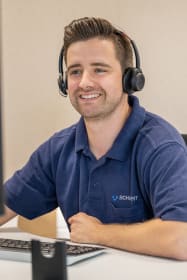The Schubert success story began in the 1960s with the initially belittled idea to build a packaging machine using standard components from which, depending on the task, exactly the right line would be assembled. In 1966, to implement his idea, Gerhard Schubert founded the Gerhard Schubert GmbH and began construction of the first carton erecting and gluing machine (SKA), with which the Weiss company in Nuremberg packaged its world-famous gingerbread “Lebkuchen”.
Over the course of the next years, the entrepreneur developed the first SSB modular machine (Schubert-Sondermaschinen-Baukasten) for filling and sealing cartons via top loading – whereby the line could be assembled from various mechanical modules depending on the task at hand.
Using the human body as model – robots in operation
In the 1970s, Gerhard Schubert was already considering how he could use robotics to maximise the flexibility and adaptability of packaging operations. The basic idea behind his vision was really quite simple: human nature would serve as the perfect model for his packaging machines. “At some point, I asked myself what was the most flexible, adaptable development that nature had ever made? The answer was the human being,” says Gerhard Schubert. “With this in mind, my vision was to develop a machine built according to human principles: simple mechanics, a high level of intelligence and the use of tools. This was the platform upon which we built our machines.”
Schubert presented the first result of these considerations in 1981 at the Interpack fair: ROBY, the first-ever packaging robot. This four-axle robot placed individual products, such as chocolates, from a feeder belt into a box or plastic tray. Schubert achieved a major breakthrough with the development of the two-axle SNC-F2 robot which was first used in 1985. Equipped with the right tool, it was possible for the first time with this robot unit to perform various packaging tasks, such as erecting boxes, filling boxes and closing boxes. An important step towards standardization.
As early as 1985, Schubert brought in its technical expertise for optical image processing with experts from the Nuclear Research Center in Karlsruhe to set up its own development department. Since then, the company has ranked among the pioneers in this key area as well, and just recently reached a new milestone with its market-ready 3D scanner. Over and above surfaces, the 3D scanner can detect volume, thereby increasing the performance options in the packaging process – for the pick & place operation as well as in quality control.
Artificial intelligence and networked production
Today, the eight basic modules now enable a highly adaptable machine structure, within which all functions, such as feeding, erecting, filling, capping/lidding/sealing, labelling, marking and palletising can be combined. In addition to the VMS control system, the two-, three- and four-axis robots, image recognition systems and the recently introduced Transmodul standard component all come together to form the basis of the TLM machines. Thanks to these rail-based robots, transport tasks can be engineered much more efficiently. At the same time, the Transmodul further increases the compactness of the TLM systems.
“Our goal is to combine intelligent software and reduced mechanics, while continuously increasing flexibility and adaptability,” explains Ralf Schubert. Based on this principle, Schubert presented the first packaging machine without an electrical cabinet at the 2014 Interpack show. Since the machine’s servo amplifiers are included within the TLM robots’ distributed control architecture, an electrical cabinet is no longer required – and the number of electronic parts could therefore be significantly reduced.
In 2016, Gerhard Schubert GmbH celebrated not only its 50th anniversary, but also the introduction of a new system component that sets new standards in the packaging of products in flowpacks. For the first time, the Flowmodul makes packaging of products such as confectionery, cosmetics and pharmaceuticals and other flowpack products seamlessly possible within its proven top-loading packaging machines. The now eighth system component in the portfolio of the packaging machine manufacturer packs small batches, short product life cycles and a high product diversity as efficiently as never before.

